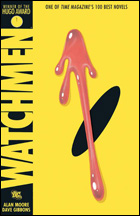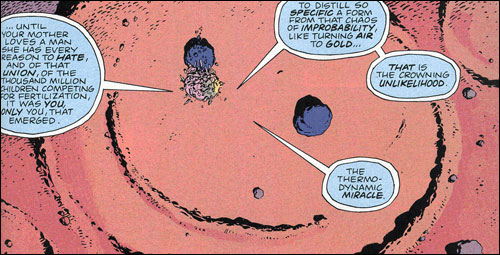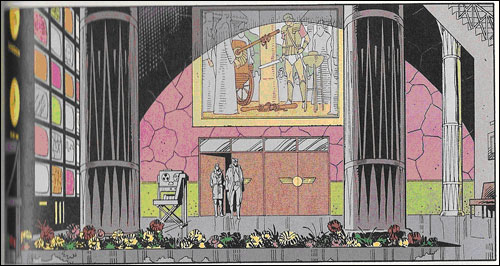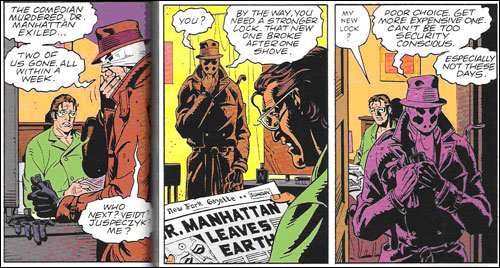Who Writes About Watchmen
 Do you remember in high school, when we had to write those dreadful English papers where we had to analyze revenge in Hamlet or describe the character of Ophelia? As an English teacher, I’m the man who gives those hated assignments, and I actually do believe in the value of analysis as an intellectual discipline. But as we all know, Hamlet is a play, meant to be performed by actors and watched by audiences. There is—and probably should be—a visual and kinesthetic component to a discussion of a dramatic work.
Do you remember in high school, when we had to write those dreadful English papers where we had to analyze revenge in Hamlet or describe the character of Ophelia? As an English teacher, I’m the man who gives those hated assignments, and I actually do believe in the value of analysis as an intellectual discipline. But as we all know, Hamlet is a play, meant to be performed by actors and watched by audiences. There is—and probably should be—a visual and kinesthetic component to a discussion of a dramatic work.
Unfortunately, we English teachers privilege the written word over any other form of communication, which is understandable, given that our inclination and training lead us in that direction. Those of us who branch out from William Shakespeare to Alan Moore, however, need to transform our approach to graphic novels. We must recognize that the panels in a comic book are not just pretty pictures and do not serve only to entice reluctant readers, but are an integral part of the experience of comics. This will allow us to show students how different modes of literacy—in this case verbal and visual literacy—interact to allow us to create meaning out of the comics medium.
The procedure I teach my students for interpreting graphic novels, which I outline below, is unfortunately followed inconsistently by professional writers on comics. Bradford W. Wright in Comic Book Nation frequently includes and analyzes the meaning of art panels as it relates to his thesis, as does Richard Reynolds in Super Heroes: A Modern Mythology. Peter Coogan’s Superhero: The Secret Origin of a Genre is a remarkable book, and he occasionally examines the meaning of the art, but only infrequently. More often, he’ll show a panel of, say, Superman simply because he is discussing Superman, and the panel itself is irrelevant. Other writers, like Geoffrey Glock in How to Read Superhero Comics and Why, and all of the contributors to Watchmen and Philosophy (edited by Mark D. White) fail to include any comic panels at all, which can be intensely frustrating for those of us who are visual learners and have to picture in our head what section of Watchmen the writer is explaining when he could simply show us the picture and explain why it is important.
In other places, I have written extensively on teaching Watchmen to my seniors in British Literature and shown that they can see the deep interactions between text and art, so I won’t take the time to repeat it here. My goal in this article is to discuss how, having taught the novel, I ask my students to write about it, and to offer student examples to show how the project works.
The basic framework of a graphic novel interpretation is unchanged from a paper on Hamlet. The suggestion I give to all my students, regardless of genre or medium, is to look for patterns of repetition—an idea that comes up over and over again. In the student examples I include in this article, Andrew examines the repetition of broken locks in the Watchmen, and Olivia looks at the repetition of Nostalgia, Adrian Veidt’s perfume, which appears in many panels. Finally, Alicia examines how and when characters embrace each other and how that repetition relates to theme. Once students recognize a pattern in the novel, interpretation simply entails determining what idea the writer is trying to communicate through that repetition.
Scaffolding the Paper: Analyze a Single Panel
Before I ask students to do a full-dress interpretation, which entails a close reading of Alan Moore’s words and a discussion of Dave Gibbons’ art, they write a short assignment in which they practice summarizing and quoting the text as well as including a single panel from Watchmen. They choose a panel, briefly summarize the section of the story that leads up to it, include the panel, and discuss the meaning of the visual image. For this preliminary assignment, Andrew examined the panel of the smiley face on Mars, after Laurie discovered that the Comedian was her father. As soon as she found out, Laurie threw a bottle of Nostalgia perfume and shattered Dr. Manhattan’s glass tower in shame and grief. It is at that moment when Dr. Manhattan realizes that Laurie’s life, and by extension all human life, is worth saving, so Moore and Gibbons signal the emotion of the moment with a Martian smiley face (see Example # 1).
Example # 1: a segment of Andrew’s panel-analysis paper

Fig. 1 – The classic Watchmen smiley face, crying a single tear of joy.
Upon Doctor Manhattan changing his mind, the tears of crying become tears of joy. In Figure 1, we can see how Manhattan’s fortress has landed just below one of the rocks of the “smiley face”, which makes the fortress look like a single tear on the face of Mars. The tear is a tear of joy because the face is smiling.
Andrew’s preliminary paper allowed him to practice all of the basic skills of panel analysis before he attempted the full dress interpretation that included several panels. He had to learn how to scan the book and crop the image, place it into his document, size it and label it clearly. It also gave him practice discussing a visual image. All my students wrote this short, relatively simple, paper, before they moved to the interpretive writing.
The Interpretive Paper
Much of my instruction about interpretation has already occurred by the time I teach Watchmen, so the basic process of examining repetitions and pulling out relevant quotations is comfortable to them. For this essay, I spend most of my time showing them how to incorporate and interpret the panels as an integral part of their analysis. Students will have done much of this for their preliminary assignment, but since the process is still new to them, I keep working with them to improve their technique. Below, I show small sections of three students’ papers to give a taste of how the assignment works.
Andrew’s Interpretation: The Gordian Knot
The repetition Andrew examines involves the Gordian Knot Lock Company. He notes that all the company’s locks break in the novel—for example, the ones Rorschach destroyed at Dan Drieberg’s house and Moloch’s apartment. He then proposes that the broken locks show an overall lack of personal security in the novel, represented by the violation of Dr. Manhattan’s privacy by Doug Roth, Edward Blake’s attempted rape of Sally Jupiter, and similar events. Finally, though, he links all of these examples to Adrian Veidt’s admiration for Alexander the Great and his solution to the Gordian Knot puzzle. Whoever could untie the knot would be king, but Alexander simply cut the knot in half. Andrew explains how Veidt cut his own Gordian knot by destroying New York with his genetically engineered monster in order to save the world from nuclear annihilation (see Example # 2). The section below starts by referring to the attack on New York.
Example # 2 A segment of Andrew’s interpretation

Fig. 4 – Rorschach and Dan Dreiberg below a painting of the Gordian Knot.
While this is an extreme example of thinking outside the box, Veidt thought exactly like Alexander the Great would have thought. In the novel, Veidt was referred by everyone around him as the “the smartest man in the world”. He certainly lived up to his name, and he was able to do the impossible – end the war. However, in figure 4, we see Rorschach and Nite Owl (who is really Dan Dreiberg) standing under Veidt’s painting of Alexander the Great slicing the Gordian knot (11.15.4). Rorschach and Nite Owl were preparing to confront Veidt about his plan and stop him from seeing it through. Once again, Veidt thought outside the box, and put his plan into action mere minutes before they were even able to confront him (11.27.1).
In this section, and throughout his essay, he thus links the repetition of broken locks to one of the major events of the novel, Veidt’s plan to destroy New York. Note how in the above example, Andrew examines the details of the panel and ties them into both the dramatic situation and the theme he is addressing in his paper.
Olivia’s Interpretation: Nostalgia by Veidt
Another student, Olivia, discusses the number of times Veidt’s perfume, Nostalgia, appears in Watchmen. In examining several different panels that refer to the product, she recognizes that in nearly all cases, the character that is found with the perfume is experiencing the longing for the past that actually constitutes nostalgia. In Example # 3 below, Olivia notices that, having reminded Dan Dreiberg of his past as a costumed adventurer earlier in the story, Rorschach returns and steals a bottle of Nostalgia from him.
Example # 3: A section of Olivia’s interpretation
In chapters one and two Dan thinks about his past as the Nite Owl because Rorshach breaks into his apartment and reminds him that he quit. He also reminisces with Laurie and thinks about the time that he worked with the Comedian. Then, in chapter 3, as we see in Figure 3, Rorshach takes Dan’s bottle of Nostalgia cologne. After that, Dan does not think about the past but thinks about the present and future. He is no longer afraid to get close to Laurie and he decides to become Nite Owl again and to free Rorshach from prison. Rorshach is the reason that Dan begins to feel the effects of Nostalgia and he is the one that takes those feelings away.

Figure 3: Rorshach taking Nostalgia from Dan
As we can see from Olivia’s example, she does a close reading of the panel, where Rorschach appropriates a bottle of perfume from his friend Dan, and ties it into a significant theme in Moore and Gibbons’ novel.
Alicia’s Interpretation: Hugs for Comfort
In her Watchmen paper, Alicia observes the numerous times that characters embrace one another for comfort, for example, when Dan dreams of hugging Laurie as they are being vaporized by a nuclear blast. She connects these images to the “Hiroshima lovers,” the spray-painted silhouettes of a man and a woman found on the sides of buildings that are reminiscent of the shadows of people imprinted on the walls of Hiroshima after the atom bomb exploded over that city. The lovers appear in many panels throughout the graphic novel, and many of the embraces the characters offer each other echo these “shadows.” In Example # 4 below, Alicia connects the hugs that characters give for comfort to an image of the newsvendor and the teenager who spends time at his newstand.
Example # 4: a section of Alicia’s interpretation
In the beginning of the book, we are introduced to Bernard, the newspaper salesman. He owns a little stand in the streets of New York. He likes to give his opinion about anything and everything. He is frequently getting visited by this boy who comes to read a magazine called The Black Freighter. Throughout the book it seems like the boy bothers Bernard, but as the end of the book comes around you see that even if you don’t necessarily care for someone, you may end up turning to them for support. In chapter 11 the doomsday clock is right on the verge of midnight. The very last page of chapter 11, there is a bright flash of light signaling the end of the world. As the light gets brighter and brighter Bernard and the boy turn towards each other. Without even speaking, they both knew that the other was probably afraid and they embraced each other (11.28.9). (See figure 2) They are still holding each other after that chapter ends. The very last panel is pure white and they are holding each other until that point.

Figure 2: Bernard and the boy hold each other in the face of danger
In all three student examples, we see how students can do a standard literary analysis—a close reading of Alan Moore’s words as they would in a Hamlet paper—and examine the artwork to show how text and graphics together add complexity and richness to a discussion of comics. This process of analysis, of course, applies to any graphic novel, not just Moore and Gibbons’ Watchmen. If we in the teaching profession are serious about bringing graphic novels into the classroom, we must instruct students how to do honor to both the written word and the art. The results can be remarkable.


